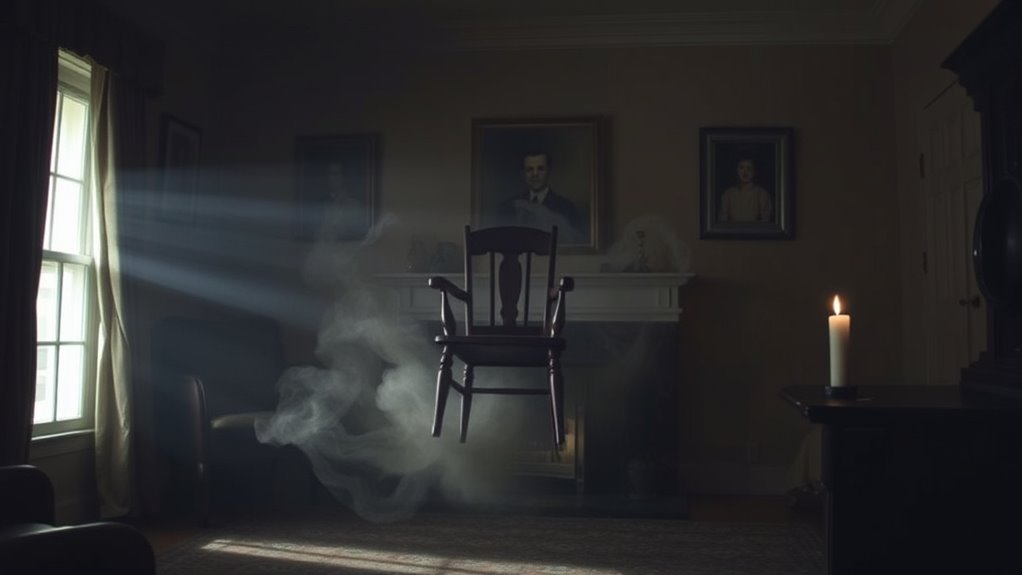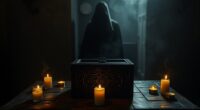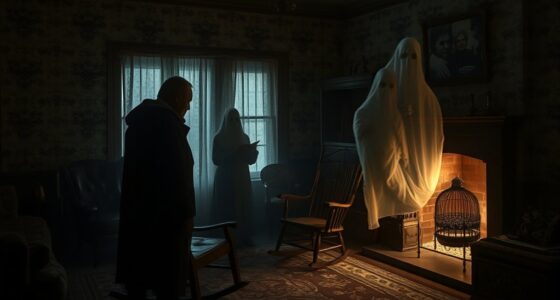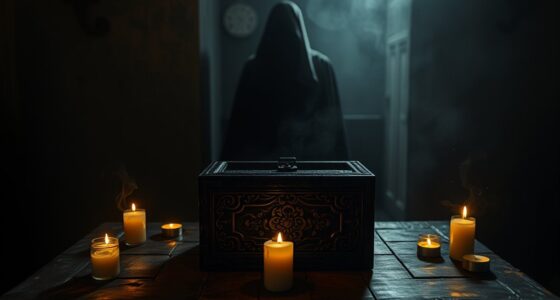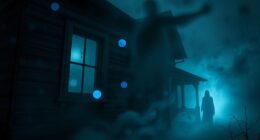The Enfield Poltergeist is a documented case involving the Hodgson family, who experienced unsettling disturbances in their London home during the late 1970s. Eerie noises, moving furniture, and unexplained cold spots led to investigations by notable figures like Maurice Grosse and Ed Warren. While some evidence and witness accounts support the paranormal claims, skepticism remains about the authenticity of the events. If you’re curious about the evidence and controversies surrounding this case, there’s much more to uncover.
Key Takeaways
- The Enfield Poltergeist case involved the Hodgson family experiencing unexplained phenomena, including knocking sounds and furniture movement in their home.
- Investigators, including Maurice Grosse and Guy Lyon Playfair, documented thousands of incidents, capturing audio and photographic evidence of the disturbances.
- Skepticism arose regarding the case, with critics suggesting potential hoaxes and questioning the authenticity of the reported events.
- Janet Hodgson later admitted to faking some occurrences, complicating the narrative and raising doubts about the case’s legitimacy.
- The cultural impact of the case led to numerous books, films, and ongoing debates about the existence of poltergeists and supernatural events.
The Hodgson Family and Their Home
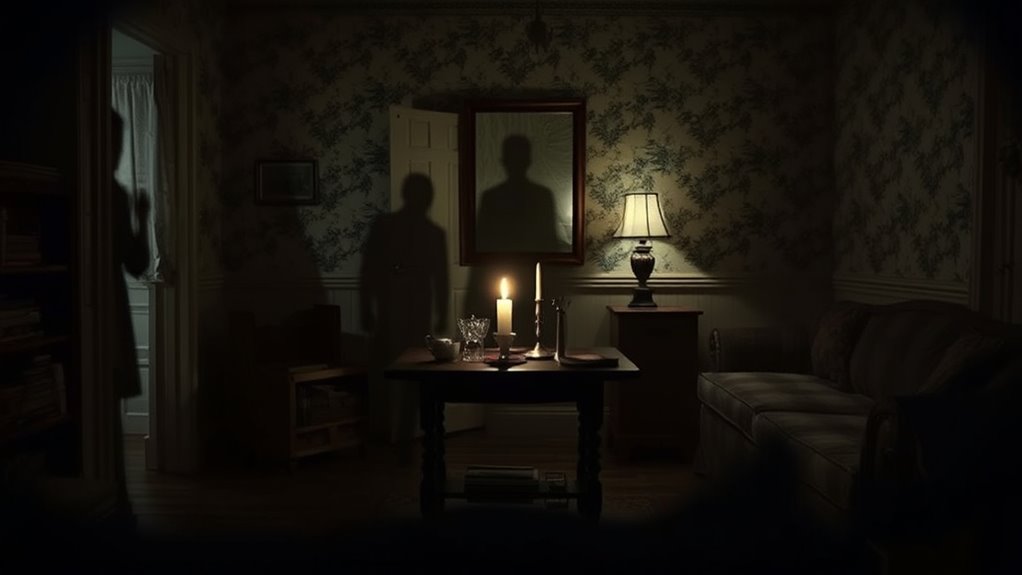
When you think about the Enfield Poltergeist, it’s hard to overlook the Hodgson family, who found themselves at the center of this unsettling phenomenon.
Living in a council house at 284 Green Street in Enfield, London, the family included four children: Margaret, Janet, Johnny, and Billy, with their mother, Peggy, raising them as a single parent. The family’s private paradises were disrupted by the eerie occurrences, as they struggled to maintain normalcy amid the chaos. This case became one of the most documented instances of paranormal phenomena, captivating both the public and skeptics alike. Many of the events reported mirrored common themes found in haunted folklore, which often revolve around family dynamics and emotional turmoil. The intense emotional responses experienced by the children may have contributed to the emotional dysregulation observed during the haunting, highlighting the importance of clear communication in times of distress.
The alleged paranormal activity primarily revolved around Janet and Margaret, enchanting the neighborhood and drawing attention from paranormal investigators like Maurice Grosse and Guy Lyon Playfair. Notably, over 30 witnesses reported experiencing strange occurrences, including furniture moving on its own.
The haunting captivated the community, drawing renowned paranormal investigators to the enigmatic experiences of Janet and Margaret.
The family’s home became infamous, as the haunting lasted nearly 18 months, leaving a lasting impact on the children’s lives and sparking widespread intrigue.
The Early Signs of Disturbance
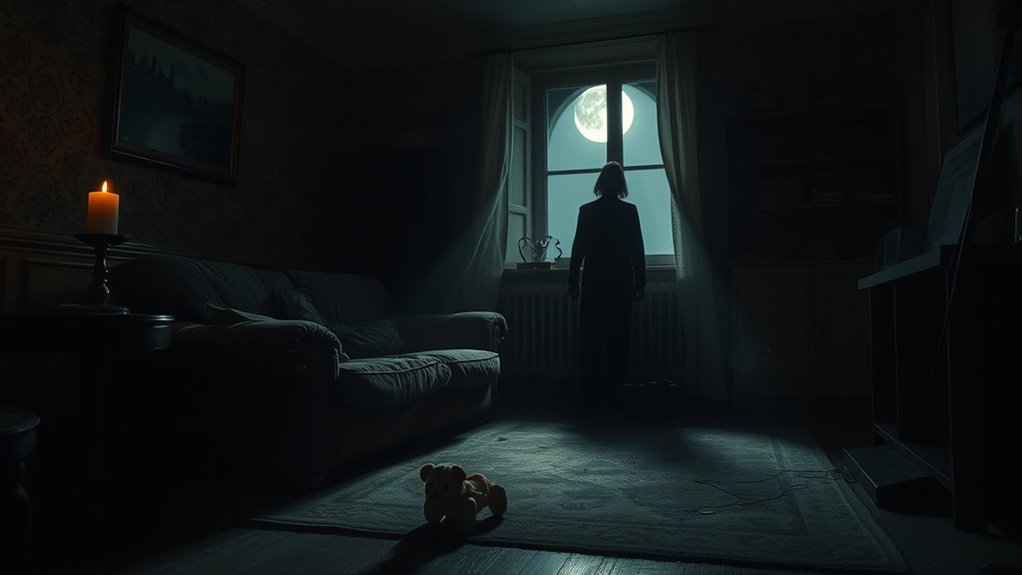
As unsettling noises began to echo through the Hodgson family’s home in August 1977, it quickly became clear that something unusual was afoot.
You’d hear knocking sounds and whispers that sent chills down your spine, especially at night when darkness enveloped the house. Cold spots appeared, intensifying the eerie atmosphere. Professional counseling may help couples reconnect in the face of emotional turmoil, providing support for families dealing with such distressing experiences. Narcissistic relationships can lead to emotional abuse, making it crucial for those affected to seek help. During times of distress, having a cooperative co-parenting plan can provide stability for children involved. In times of uncertainty, seeking professional support can be vital for addressing emotional turmoil. Additionally, routine health checks can help individuals maintain their well-being during stressful periods.
Initially, you might’ve thought the disturbances were just mischievous antics of the children, but as the occurrences grew more alarming, it became evident that something more sinister lurked within the walls. The Hodgson family reported strange phenomena such as furniture moving on its own, further heightening the sense of dread.
Creaking floorboards and unexplained noises filled the air, creating a tension that was palpable. Despite no evidence of natural causes, the unsettling events left you questioning the very nature of your home and the reality surrounding you.
Key Figures in the Investigation
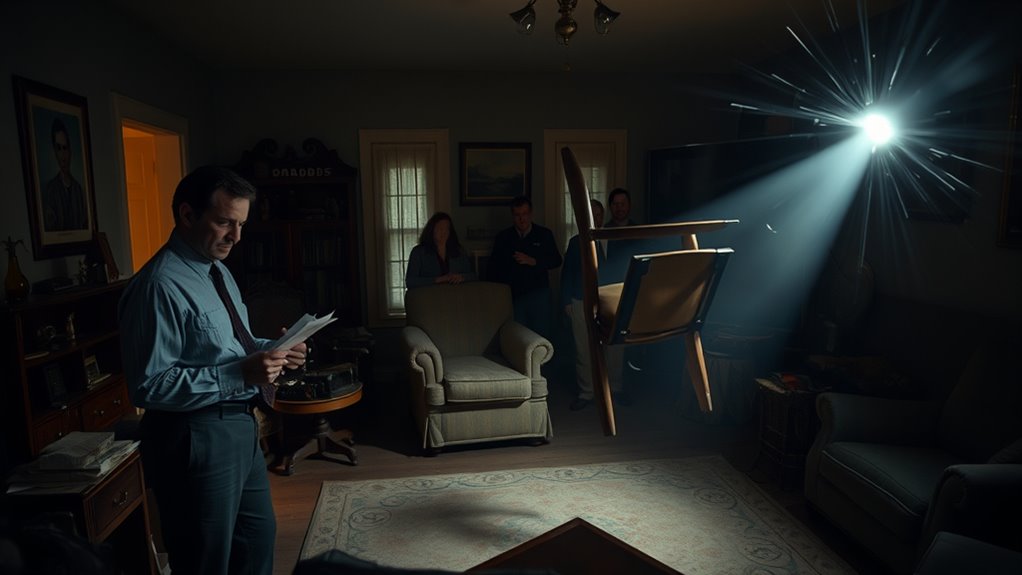
Several key figures played essential roles in investigating the Enfield Poltergeist, each bringing unique expertise to the case.
Maurice Grosse led the investigation for the Society for Psychical Research, making over 180 visits and conducting more than 25 all-night vigils alongside Guy Lyon Playfair, who meticulously documented the events. Ed and Lorraine Warren added global publicity and their renowned paranormal insights, while Rosalind Morris contributed through BBC Radio 4, increasing public awareness. Their combined efforts resulted in over 180 hours of audio recordings and detailed reports, showcasing various phenomena. Notably, the Warrens’ involvement sparked controversy regarding sensationalism of events. Furthermore, the investigators utilized various phenomena that captured the public’s imagination, ensuring its significance in paranormal studies remains strong today. They found that transformative tools like audio recordings could enhance understanding of the phenomena. In addition to their investigative work, the team also faced challenges in navigating ethical decision-making frameworks, ensuring the integrity of their findings. Their collaborative approach mirrors the principles of personalized learning, as they adapted their strategies to meet the unique challenges presented by the case. Prophetic dreams, often seen as divine communication, were also discussed by some investigators as a means of understanding the deeper implications of the events. Despite facing skepticism, these investigators’ dedication laid the groundwork for ongoing discussions about the case, ensuring its significance in paranormal studies remains strong today.
Documented Paranormal Events
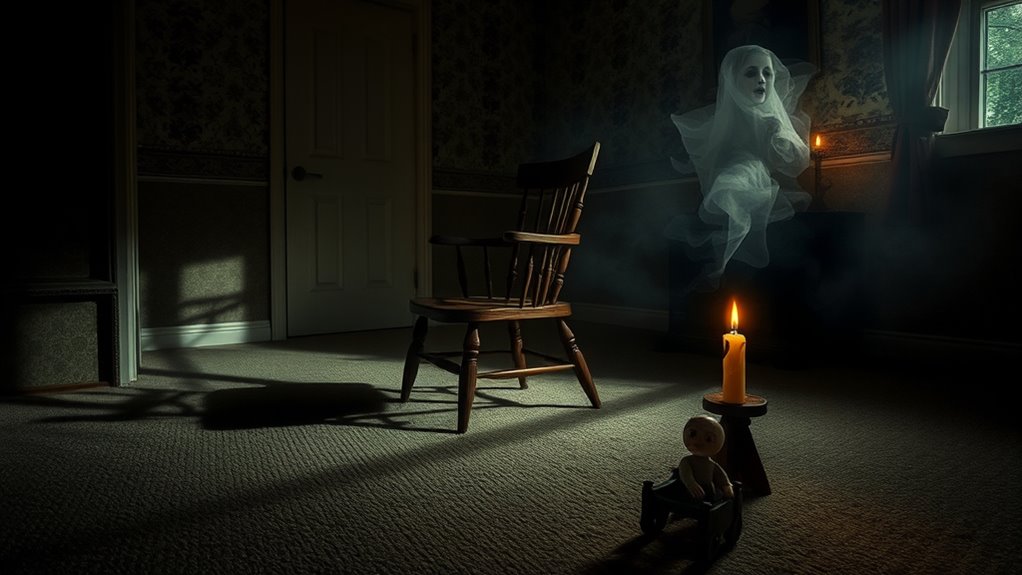
The Enfield Poltergeist case is marked by a series of unsettling events that took place at 284 Green Street in Brimsdown, London, from 1977 to 1979. The alleged poltergeist activity centered on sisters Janet and Margaret Hodgson, who experienced strange happenings that left many bewildered. You’d hear knocking in the walls, see furniture being thrown, and witness other unexplained movements. These events drew attention from various witnesses, including BBC journalists and police officers, all of whom reported witnessing the bizarre phenomena firsthand. Initial reports surfaced in August 1977, and by November, the story gained traction through BBC’s Nationwide. The haunting’s authenticity sparked debates, but it undeniably captured public interest and remains a significant chapter in paranormal history, with 17 witnesses contributing to the ongoing discussions and skepticism surrounding the case. Additionally, the involvement of AI technologies in analyzing such phenomena has opened new avenues for understanding and documenting these occurrences. Many individuals are drawn to such stories, often influenced by narcissistic tendencies that can skew perception and interpretation of events. Furthermore, the public fascination with such cases often reflects a desire for financial literacy, as understanding the financial implications of paranormal investigations can lead to more informed decisions. Notably, the intense scrutiny and interest in such cases can sometimes mirror the time-efficient application seen in other fields, emphasizing the allure of quick results in the pursuit of understanding the unknown. As robust safety measures become necessary in AI, they may also contribute to more accurate assessments of purported paranormal activities.
Evidence Collected by Investigators
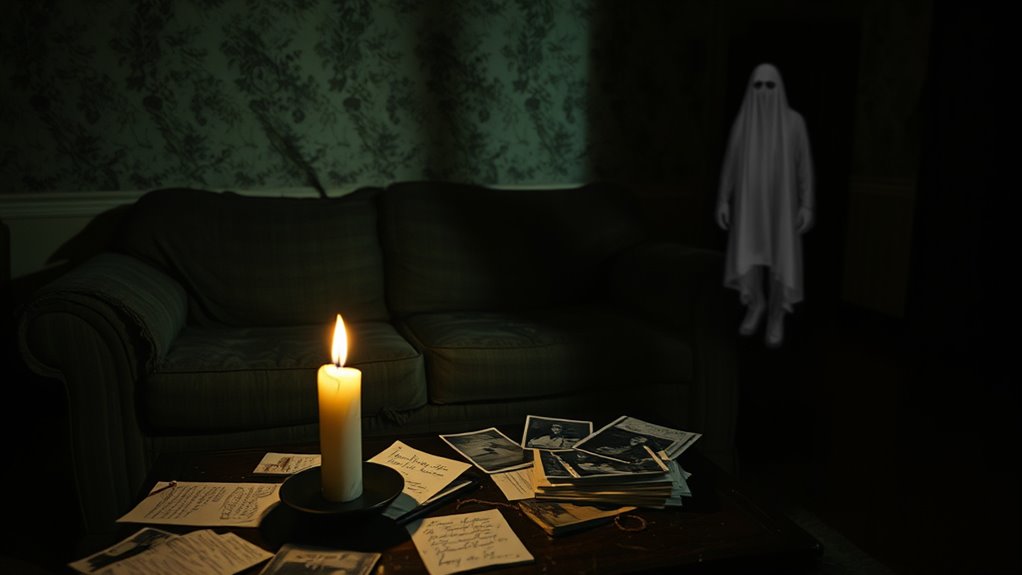
Investigators collected a variety of evidence to support claims of paranormal activity in the Enfield Poltergeist case. They utilized audio recordings to capture voices purportedly from the poltergeist, often communicated through Janet Hodgson. The emotional toll of such experiences can be profound, often leading to significant emotional distress for those involved. Additionally, the fear of abandonment experienced by individuals involved in intense situations can exacerbate emotional instability. This emotional turmoil can be a significant barrier to processing loss and moving forward after such extraordinary events.
Photographic evidence included images suggesting levitation, while visual surveillance aimed to document movements and verify claims. Witness testimonies from family members and visitors further enriched the narrative. Notable upcoming adaptations like a West End play and a docu-drama on Apple TV+ continue to highlight the story’s enduring impact.
Key figures like Maurice Grosse and Guy Lyon Playfair meticulously documented thousands of incidents. They used tape recorders, cameras, and video equipment to gather data. Establishing healthy boundaries during the investigation allowed the investigators to maintain a clear focus on the evidence without becoming emotionally involved. Open communication among the investigators was crucial to ensure that personal feelings did not cloud their judgment.
Despite this, challenges arose, such as concerns over authenticity and varying interpretations of evidence. Overall, the collected evidence aimed to substantiate the extraordinary events occurring at the Hodgson home.
Skepticism and Criticism
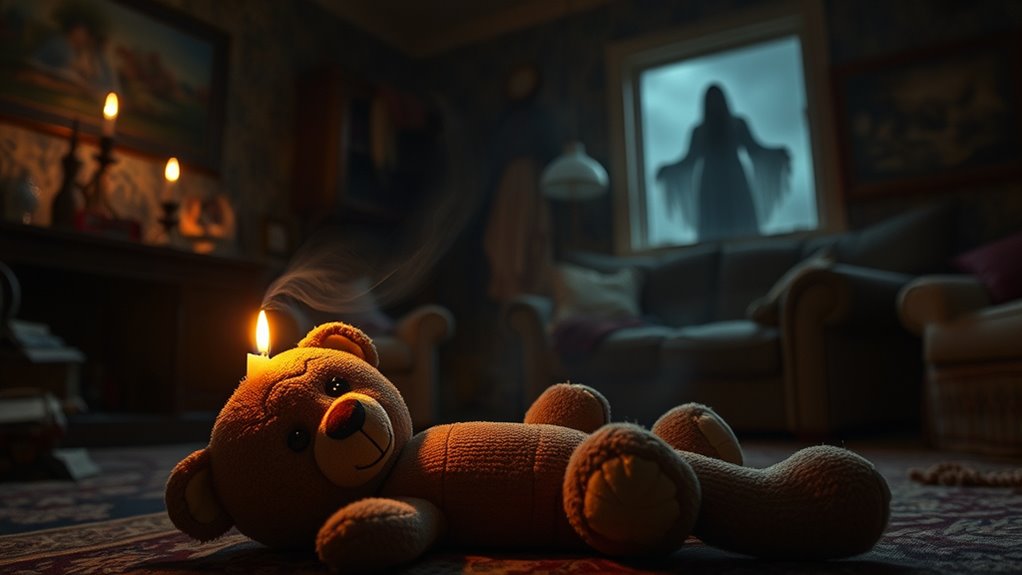
While many enthusiasts embrace the Enfield Poltergeist case as a genuine paranormal phenomenon, skeptics raise significant concerns about the evidence and investigative methods used.
They argue that the alleged voice of Janet Hodgson might’ve come from her false vocal cords, rather than a ghost. Critics like Joe Nickell point out that investigators often misinterpreted natural occurrences as supernatural, leading to claims of levitation that some attribute to pranks. The Society for Psychical Research faced backlash for encouraging potential hoaxes by providing a platform for such claims. Moreover, many phenomena lacked objective evidence, and technical issues with recording equipment were mistaken for paranormal activity. The case’s lasting impact and the emotional connection of investigator Maurice Grosse may have further clouded the objectivity of the investigation.
Media Coverage and Public Reaction
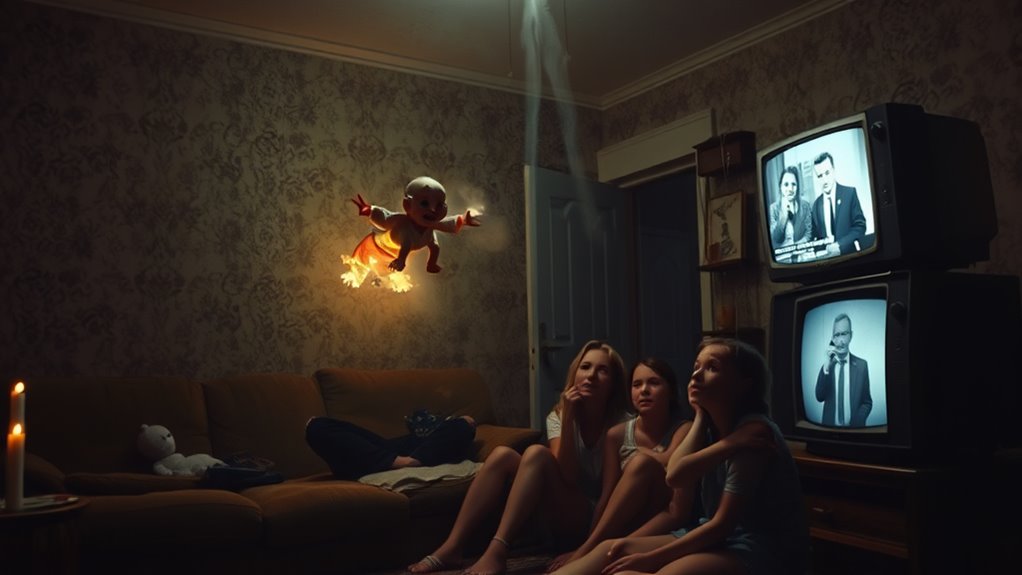
As media outlets began to cover the Enfield Poltergeist case in 1977, public interest skyrocketed, sparking debates about the authenticity of the reported phenomena.
The Daily Mirror was among the first to break the story, followed by extensive coverage from the BBC on its show “Nationwide.”
The Daily Mirror initiated coverage of the Enfield Poltergeist, with the BBC’s “Nationwide” following suit.
Documentaries, like Jerry Rothwell’s recent series, utilized original audio recordings, while dramatizations such as Sky’s “The Enfield Haunting” brought the events to life. The Enfield Poltergeist is attributed as one of the best-documented cases of paranormal activity in Europe.
Public opinion remained divided; some believed in the paranormal activity, while others dismissed it as a hoax.
The media frenzy turned the case into a spectacle, enchanting many despite the controversy. Its well-documented nature solidified its position as a fascinating topic in the domain of alleged ghost stories.
Cultural Impact and Legacy
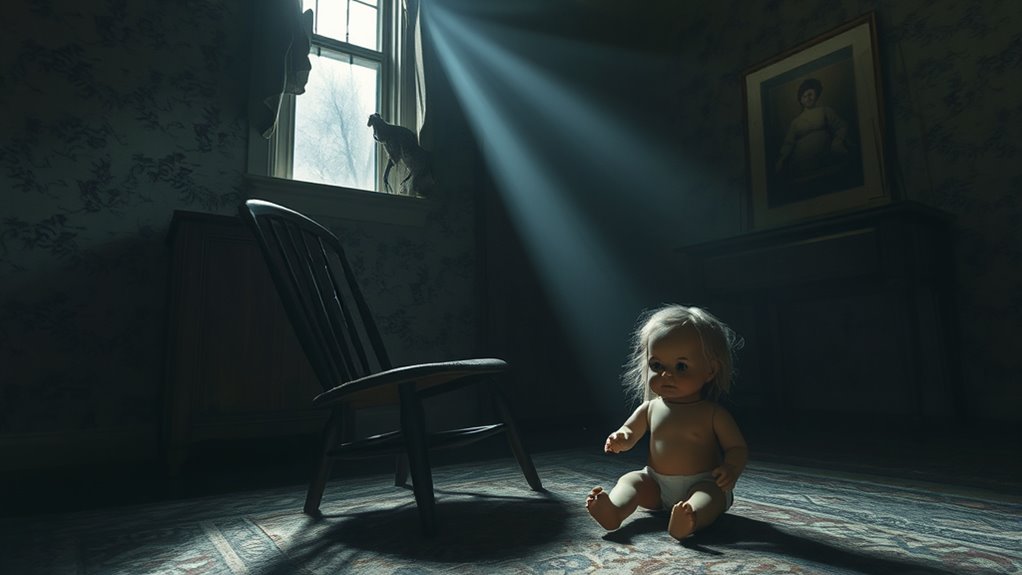
The Enfield Poltergeist case not only fascinated the public through media coverage but also left a lasting cultural impact that continues to resonate today. Occurring in the late 1970s, it sparked widespread discussions about the supernatural, influencing beliefs and investigations into poltergeist phenomena. The alleged poltergeist phenomena experienced by the Hodgson family, particularly those of sisters Janet and Margaret, captivated audiences and inspired numerous books, films like “The Conjuring 2,” and documentaries. This case also prompted debates among paranormal researchers regarding evidence standards and methodologies.
The Ongoing Debate on Truth and Hoax

Amidst the ongoing fascination with the Enfield Poltergeist case, debates about its authenticity continue to swirl. You’ll find a split between those who believe in genuine supernatural events and skeptics who suspect a hoax. Investigators from the Society for Psychical Research (SPR) gathered evidence, while critics from the Committee for the Scientific Investigation of Claims of the Paranormal (CSICOP) point to potential trickery. Janet’s admission of faking some incidents complicates matters, leaving you to wonder about the extent of the deception. Some researchers argue the phenomena were authentic, while others suggest psychological explanations. In addition, the involvement of paranormal investigators like Maurice Grosse and Guy Lyon Playfair has fueled the debate. With no consensus among experts, the Enfield case remains an enthralling mystery, inviting you to ponder the fine line between belief and skepticism.
Frequently Asked Questions
What Were the Psychological Effects on the Hodgson Family During the Events?
During stressful events, you might find that psychological effects can deeply influence family dynamics.
For the Hodgson family, anxiety and fear likely heightened due to ongoing disturbances. The media’s scrutiny could create pressure, making you question your reality.
Children, especially, could be impacted by their imaginations and past traumas, leading to potential psychological breaks.
Support systems play an essential role, as a lack of them can exacerbate feelings of isolation and stress.
How Did the Local Community React to the Poltergeist Claims?
You’d notice a mix of fascination and skepticism in the local community regarding the poltergeist claims.
Many neighbors showed curiosity, discussing the strange occurrences and supporting the Hodgson family.
However, some remained doubtful, questioning the authenticity of the events.
The media amplified this divide, leading to public debates and extensive coverage.
Did the Hodgson Family Seek Help From Religious Figures?
When you consider that nearly 70% of families experiencing paranormal activity seek help from religious figures, it’s no surprise the Hodgson family turned to clergymen.
They consulted two, hoping blessings would quell the unsettling events in their home.
Unfortunately, the advice to redecorate and change habits didn’t alleviate the disturbances.
Even skeptics acknowledged the clergymen’s involvement as part of their broader search for a solution, though results remained elusive.
What Happened to the House After the Poltergeist Activity Ceased?
After the poltergeist activity ceased, you’d find the house returned to a quieter state, but its reputation lingered.
Many people remained curious about its haunted past, leading to occasional visits from ghost hunters and paranormal enthusiasts.
The neighborhood buzzed with stories, and the home became a local landmark.
Over time, the house was renovated, but its history still captivates those who hear about the strange occurrences that once unfolded within its walls.
Are There Any Modern Investigations of the Enfield Poltergeist Case?
Yes, there are modern investigations of the Enfield Poltergeist case.
Researchers and paranormal enthusiasts continue to explore the events using advanced technology like EVP recorders and thermal cameras.
Documentaries and podcasts often revisit the case, analyzing old evidence and presenting new theories.
You might find that these investigations spark renewed interest, as they question the authenticity of the phenomena and probe into psychological explanations behind the experiences reported by the Hodgson family.
Conclusion
In the end, the Enfield poltergeist case leaves you questioning the line between reality and the supernatural. While some argue it was a hoax, others remain convinced of its authenticity. Consider the story of the Bell Witch, another famous haunting that sparked similar debates. Just like in Enfield, the blend of fear, belief, and skepticism creates an enduring mystery. Whether you believe or not, these tales challenge you to explore the unknown, pushing the boundaries of what you accept as real.
